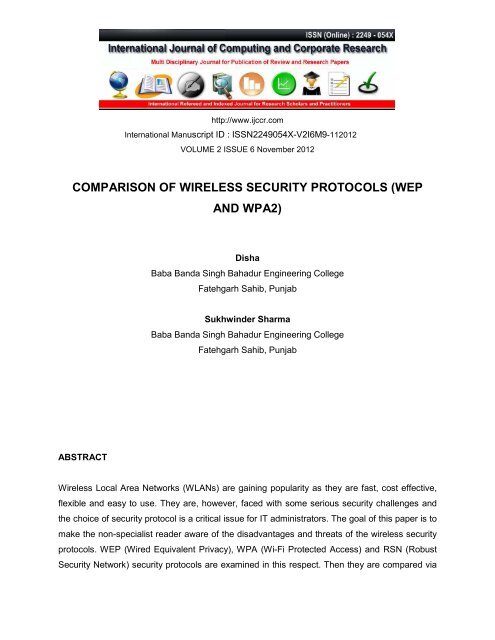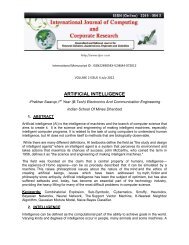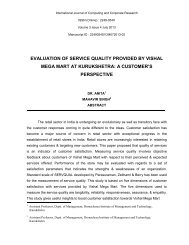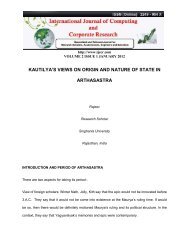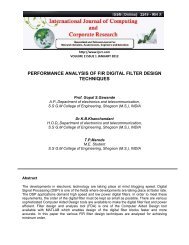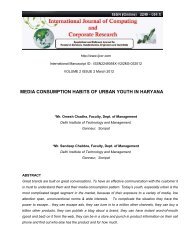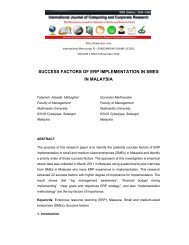comparison of wireless security protocols (wep and wpa2) - Ijccr.com
comparison of wireless security protocols (wep and wpa2) - Ijccr.com
comparison of wireless security protocols (wep and wpa2) - Ijccr.com
Create successful ePaper yourself
Turn your PDF publications into a flip-book with our unique Google optimized e-Paper software.
http://www.ijccr.<strong>com</strong>International Manuscript ID : ISSN2249054X-V2I6M9-112012VOLUME 2 ISSUE 6 November 2012COMPARISON OF WIRELESS SECURITY PROTOCOLS (WEPAND WPA2)DishaBaba B<strong>and</strong>a Singh Bahadur Engineering CollegeFatehgarh Sahib, PunjabSukhwinder SharmaBaba B<strong>and</strong>a Singh Bahadur Engineering CollegeFatehgarh Sahib, PunjabABSTRACTWireless Local Area Networks (WLANs) are gaining popularity as they are fast, cost effective,flexible <strong>and</strong> easy to use. They are, however, faced with some serious <strong>security</strong> challenges <strong>and</strong>the choice <strong>of</strong> <strong>security</strong> protocol is a critical issue for IT administrators. The goal <strong>of</strong> this paper is tomake the non-specialist reader aware <strong>of</strong> the disadvantages <strong>and</strong> threats <strong>of</strong> the <strong>wireless</strong> <strong>security</strong><strong>protocols</strong>. WEP (Wired Equivalent Privacy), WPA (Wi-Fi Protected Access) <strong>and</strong> RSN (RobustSecurity Network) <strong>security</strong> <strong>protocols</strong> are examined in this respect. Then they are <strong>com</strong>pared via
http://www.ijccr.<strong>com</strong>International Manuscript ID : ISSN2249054X-V2I6M9-112012VOLUME 2 ISSUE 6 November 2012The WEP was designed to provide the <strong>security</strong> <strong>of</strong> a wired LAN by encryption through use <strong>of</strong> theRC4 algorithm with two side <strong>of</strong> a data <strong>com</strong>munication.Wired Equivalent Privacy (WEP).WEP [2] is an encryption algorithm developed by an IEEE volunteer group. The aim <strong>of</strong> WEPalgorithm is to provide a secure <strong>com</strong>munication over radio signals between two end users <strong>of</strong> aWLAN. WEP employs RC4 algorithm for encryption <strong>and</strong> uses two key sizes: 40 bit <strong>and</strong> 104 bit;to each is added a 24-bit initialization vector (IV) which is transmitted directly. At the transmitterside the plaintext is XOR'ed with the key stream, generated after KSA <strong>and</strong> PRGA process <strong>of</strong>RC4 <strong>and</strong> cipher text is obtained. These steps take place in the reverse order at the receiver sideusing the same key. WEP uses CRC-32 algorithm for data integrity.Fig 1. WEP Encryption
http://www.ijccr.<strong>com</strong>International Manuscript ID : ISSN2249054X-V2I6M9-112012VOLUME 2 ISSUE 6 November 2012WEP Encryption:Fig 2. WEP DecryptionThere have been problems with WEP due to many <strong>security</strong> issues. In the 802.11 st<strong>and</strong>ard,WEP is defined as "protecting authorized users <strong>of</strong> a WLAN from casual eavesdropping." Assuch, WEP is not a terribly strong form <strong>of</strong> protection <strong>and</strong> is subject to numerous exploits basedon vulnerabilities <strong>and</strong> weaknesses.Attacking a WEP networkSome flaws in WEP make it crackable. The IV is sent as plaintext with the encrypted packet.Therefore, anyone can easily sniff this information out <strong>of</strong> the airwave <strong>and</strong> thus learn the firstthree characters or the secret key. Both the KSA <strong>and</strong> PRGA leak information during the first fewiterations <strong>of</strong> their algorithm. XOR is a simple process that can be easily used to deduce anyunknown value if the other two values are known. The format is (B + 3, 255, x) where B is thebyte <strong>of</strong> the secret key being cracked.
http://www.ijccr.<strong>com</strong>International Manuscript ID : ISSN2249054X-V2I6M9-112012VOLUME 2 ISSUE 6 November 2012In order to sufficiently crack a real-life WEP key <strong>of</strong> a <strong>wireless</strong> AP, we need to gather lots <strong>of</strong>initialization vectors (IVs). Normal network traffic does not typically generate these IVs veryquickly. Theoretically, if you are patient, you can gather sufficient IVs to crack the WEP key bysimply listening to the network traffic <strong>and</strong> saving them. However, in this work, we use atechnique called injection to speed up the process. Injection involves having the AP resendselected packets over <strong>and</strong> over again very rapidly. This allows us to capture a large number <strong>of</strong>IVs in a short period <strong>of</strong> time. Once we have captured a large number <strong>of</strong> IVs, we can use them todetermine the WEP key. In practice WEP cracking can easily be demonstrated using tools suchas Aircrack.Procedure for Cracking WEP:STEP 1 <strong>wireless</strong> card detection.Figure 1 Detection <strong>of</strong> <strong>wireless</strong> card.Step 2 Network scanning.
http://www.ijccr.<strong>com</strong>International Manuscript ID : ISSN2249054X-V2I6M9-112012VOLUME 2 ISSUE 6 November 2012Figure 2. Network scanningStep 3 Data capturing.Figure 3. Data capturing.
http://www.ijccr.<strong>com</strong>International Manuscript ID : ISSN2249054X-V2I6M9-112012VOLUME 2 ISSUE 6 November 2012STEP 4 WEP cracking.Figure 4 WEP cracking.Test Results:Security Mechanism: WEP (40 bit), Time Required: 15-20 min, Mode: Adhoc. Beacon, frames:10000 IV’s captured: 15000, Result: Successful.WEP WEAKNESSES:1. A high percentage <strong>of</strong> <strong>wireless</strong> networks have WEP disabled because <strong>of</strong> the administrativeoverhead <strong>of</strong> maintaining a shared WEP key.2. WEP has the same problem as all systems based upon shared keys: any secret held by morethan one person soon be<strong>com</strong>es public knowledge. An example is an employee who leaves a<strong>com</strong>pany ... the employee still knows the shared WEP key <strong>and</strong> could sit outside the <strong>com</strong>pany
http://www.ijccr.<strong>com</strong>International Manuscript ID : ISSN2249054X-V2I6M9-112012VOLUME 2 ISSUE 6 November 2012sniffing network traffic or even attacking the internal network.3. The initialization vector that seeds the WEP algorithm is sent in the clear.4. The WEP checksum is linear <strong>and</strong> predictable.Wi-Fi Protected Access (WPA)It is an effort to over<strong>com</strong>e the <strong>security</strong> limitations <strong>of</strong> WEP. WPA is subset <strong>of</strong> the IEEE's 802.11i<strong>wireless</strong> <strong>security</strong> specification.WPA's encryption method is the Temporal Key Integrity Protocol (TKIP). TKIP addresses theweaknesses <strong>of</strong> WEP by including a per-packet mixing function, a message integrity check, anextended initialization vector, <strong>and</strong> a re-keying mechanism. WPA provides "strong" userauthentication based on 802.1 xs <strong>and</strong> the Extensible Authentication Protocol (EAP). WPAdepends on a central authentication server such as RADIUS to authenticate each user.Wi-Fi Protected Access is a subset <strong>of</strong> <strong>and</strong> will be <strong>com</strong>patible with IEEE 802.11i (sometimesreferred to as WPA2), a <strong>security</strong> st<strong>and</strong>ard under development. S<strong>of</strong>tware updates that will allowboth server <strong>and</strong> client <strong>com</strong>puters to implement WPA are expected to be<strong>com</strong>e widely availableduring 2003. Access points (see hot spots) can operate in mixed WEP/WPA mode to support
http://www.ijccr.<strong>com</strong>International Manuscript ID : ISSN2249054X-V2I6M9-112012VOLUME 2 ISSUE 6 November 2012both WEP <strong>and</strong> WPA clients. However, mixed mode effectively provides only WEP-level <strong>security</strong>for all users. Home users <strong>of</strong> access points that use only WPA can operate in a special homemodein which the user need only enter a password to be connected to the access point. Thepassword will trigger authentication <strong>and</strong> TKIP encryption.Procedure for Cracking WPA2:Step 1 Card detection <strong>and</strong> network scanning:Step 2: WPA/WPA2 Cracking:
http://www.ijccr.<strong>com</strong>International Manuscript ID : ISSN2249054X-V2I6M9-112012VOLUME 2 ISSUE 6 November 2012Test Results:Security Mechanism: WPA2, Mode: Infrastructure, Time Required: 10 min, Attack Type:Dictionary.Result: SuccessfulCONCLUSIONWireless networks are be<strong>com</strong>ing the most rapidly spread technology over the world; thus, theyshould be well protected, in order to prevent exploitation <strong>of</strong> confidential data. In this paper <strong>wep</strong>resented a brief overview <strong>of</strong> them, focusing on three main <strong>security</strong> <strong>protocols</strong> WEP, WPA <strong>and</strong>WPA2. We discussed <strong>and</strong> presented the overall detail procedure for cracking WEP <strong>and</strong> WPA2.Our motivation was the need for increased <strong>wireless</strong> <strong>security</strong> <strong>and</strong> the <strong>com</strong>mon feel thatnowadays WPA/WPA2 <strong>security</strong> <strong>protocols</strong> are difficult for a stranger to hack; however, our study
http://www.ijccr.<strong>com</strong>International Manuscript ID : ISSN2249054X-V2I6M9-112012VOLUME 2 ISSUE 6 November 2012depicted that any <strong>wireless</strong> network may be suffering from successful hacking attempts, if it is notcarefully setup <strong>and</strong> protected.V. REFERENCES:• SANS Institute Reading Room site “The evolution <strong>of</strong> <strong>wireless</strong> <strong>security</strong> in 802.11networks: WEP, WPA <strong>and</strong> 802.11 st<strong>and</strong>ards”.• Alex<strong>and</strong>er Gutjahr “Wired Equivalent Privacy (WEP) Functionality, Weak Points,Attacks”.• Scott Fluhrer, Itsik Mantin <strong>and</strong> Adi Shamir “Weakness in Key Scheduling Algorithm OfRC4”.• Bernard Menezes “Network Security <strong>and</strong> Cryptography”.• G. Zeynep Gurkas, A. Halim Zaim, M. Ali Aydin “Security Mechanisms And TheirPerformance Impacts On Wireless Local Area Networks”.• http://www.aircrack-ng.org/• Sebastin Bohn & Stephan Grob. 2006. An automated system interoperability test bed forWPA <strong>and</strong> WPA2. IEEE Xplore• White paper. July 2008. WLAN Security Today: Wireless more secure than wired.Siemens Enterprise Communications.• Joon S.Park & Derrick Dicoi. 2003. WLAN Security: Current <strong>and</strong> Future „Wireless LANdeployment improves users‟ mobility, but it also brings a range <strong>of</strong> <strong>security</strong> issues thataffect emerging st<strong>and</strong>ards <strong>and</strong> related technologies. IEEE <strong>com</strong>puter society.• Karen Scarfone, Derrick Dicoi, Matthew Sexton & Cyrus Tibbs. July 2008. Guide toSecuring Legacy IEEE 802.11 Wireless Networks. NIST Special Publication 800-48Revision 1.
http://www.ijccr.<strong>com</strong>International Manuscript ID : ISSN2249054X-V2I6M9-112012VOLUME 2 ISSUE 6 November 2012• Anthon James. 2002. Using IEEE 802.1x to Enhance Network Security. FoundaryNetworks.• Andrea Bittau, Mark H<strong>and</strong>ley &Joshua Lackey. 2006. The Final Nail in WEP‟s C<strong>of</strong>fin.IEEE Symposium on Security <strong>and</strong> Privacy, IEEE Computer society. Martin Beck. 8November2008. Practical attacks against WEP <strong>and</strong> WPA. IEEE <strong>com</strong>puter Society.• Jin Hong & Palash Sarkar. 2005. “Rediscovery <strong>of</strong> Time Memory Trade<strong>of</strong>fs”.• David A. McGrew. November2002. “Counter Mode Security: Analysis <strong>and</strong>Re<strong>com</strong>mendations”, Cisco Systems.• Prasad, N. R., <strong>and</strong> A. R. Prasad (eds.), WLAN Systems <strong>and</strong> Wireless IP for NextGeneration Communications, Norwood, MA: Artech House, January 2002.• Black, U., Internet Security Protocols: Protecting IP Traffic, Upper Saddle River, NJ:Prentice Hall, 2000.


